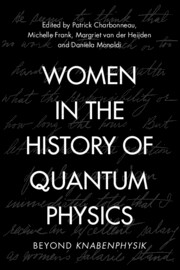Book contents
- Women in the History of Quantum Physics
- Women in the History of Quantum Physics
- Copyright page
- Contents
- Contributors
- Foreword
- Introduction
- 1 The Spectrum of He+ as a Proving Ground for Bohr’s Model of the Atom: A Legacy of Williamina Fleming’s Astrophysical Discovery
- 2 H. Johanna van Leeuwen, the Other Scientist behind the Bohr–Van Leeuwen Theorem
- 3 Hertha Sponer, Maven of Quantum Spectroscopy
- 4 Angular and Career Momentum: What Lucy Mensing Contributed to Physics and Why She Left the Field
- 5 Discouraging Jane: Dewey Among the Lucky Generation of US Physicists
- 6 Laura Chalk and the Stark Effect
- 7 Elizabeth Monroe Boggs: From Quantum Chemistry to the Manhattan Project
- 8 Excelsior! John Wheeler, Katharine Way, and the Role of Women in the Exploration of the Microcosm
- 9 Sonja Ashauer from São Paulo to Cambridge: A Journey to Quantum Electrodynamics
- 10 Untangling Entanglement History: Early Quantum Contributions of Chien-Shiung Wu
- 11 From Quantum Physics to Ethics: Grete Hermann on Heisenberg’s Cut
- 12 Women Take the Lead: A Physics Laboratory Under the Dictatorship in Portugal, 1940s–1960s
- 13 Carolyn Parker’s Electronic Frequencies
- 14 The Chew–Low–Salzman Method and Freda Friedman Salzman: A Physicist Between Nuclear and Social Interactions
- 15 Out of the Ivory Tower: Maria Lluïsa Canut and X-Ray Crystallography
- 16 Ana María Cetto Kramis: Light in Quantum Mechanics and Open Science
- Index
- References
13 - Carolyn Parker’s Electronic Frequencies
Published online by Cambridge University Press: 02 July 2025
- Women in the History of Quantum Physics
- Women in the History of Quantum Physics
- Copyright page
- Contents
- Contributors
- Foreword
- Introduction
- 1 The Spectrum of He+ as a Proving Ground for Bohr’s Model of the Atom: A Legacy of Williamina Fleming’s Astrophysical Discovery
- 2 H. Johanna van Leeuwen, the Other Scientist behind the Bohr–Van Leeuwen Theorem
- 3 Hertha Sponer, Maven of Quantum Spectroscopy
- 4 Angular and Career Momentum: What Lucy Mensing Contributed to Physics and Why She Left the Field
- 5 Discouraging Jane: Dewey Among the Lucky Generation of US Physicists
- 6 Laura Chalk and the Stark Effect
- 7 Elizabeth Monroe Boggs: From Quantum Chemistry to the Manhattan Project
- 8 Excelsior! John Wheeler, Katharine Way, and the Role of Women in the Exploration of the Microcosm
- 9 Sonja Ashauer from São Paulo to Cambridge: A Journey to Quantum Electrodynamics
- 10 Untangling Entanglement History: Early Quantum Contributions of Chien-Shiung Wu
- 11 From Quantum Physics to Ethics: Grete Hermann on Heisenberg’s Cut
- 12 Women Take the Lead: A Physics Laboratory Under the Dictatorship in Portugal, 1940s–1960s
- 13 Carolyn Parker’s Electronic Frequencies
- 14 The Chew–Low–Salzman Method and Freda Friedman Salzman: A Physicist Between Nuclear and Social Interactions
- 15 Out of the Ivory Tower: Maria Lluïsa Canut and X-Ray Crystallography
- 16 Ana María Cetto Kramis: Light in Quantum Mechanics and Open Science
- Index
- References
Summary
The chapter illustrates what it meant for Carolyn Beatrice Parker (1917–1966) to be a Black woman physicist in the US during the Jim Crow era. Her father, a physician, and her mother, a teacher, shepherded her into Fisk University, an historically Black college. As a physics major she studied infrared spectroscopy with the Black physicist Elmer Imes, graduating with a BS in 1938. She later attended the University of Michigan, obtaining an MA in physics in 1941. But like many Black women, she spent time before and after graduate school teaching in the K–12 system. In 1943, she became a research physicist at the Aircraft Radio Laboratory in Dayton, Ohio, where she stayed for four years. Although she co-authored a governmental report about her work on signal attenuation in coaxial cables, her name only appeared in the acknowledgments of the ensuing academic publications, thus partly obscuring her contributions. In 1947, Fisk University welcomed Parker on the faculty, but she soon after enrolled in a nuclear physics PhD program at the Massachusetts Institute of Technology. After dropping out, she worked as a laboratory technician until she grew too ill and died a short time later.
Keywords
Information
- Type
- Chapter
- Information
- Women in the History of Quantum PhysicsBeyond <i>Knabenphysik</i>, pp. 361 - 383Publisher: Cambridge University PressPrint publication year: 2025
